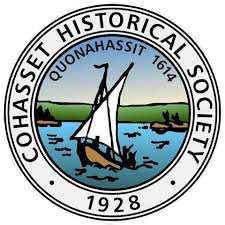The settlement in Cohasset began around 1747 when the First Parish Meetinghouse was anchored. The initial residents of the town were merchants, fishermen, and shipbuilders, since these were the thriving economic activities at that time. These and many other facts that shaped the development of the town can be found at the Cohasset Historic District. The district surrounds the Town Common and Village in Cohasset and it features the Second Congregational Church, Town Hall, and St. Stephen’s Church. You will also see a variety of houses built in both the Federal and Georgian styles which display the architectural conservatism that has been well-maintained throughout the town since the early days. One look at Cohasset's town seal shows much effort to incorporate the town's history into that seal. The origins of Cohasset were with the town of Hingham. It was known as that town's 2nd precinct or 2nd parish and labeled East Hingham. It is said the town was found as early as 1614 when Captain John Smith was exploring the coast of New England. What those explorers found back then as well as anyone exploring the coast of Cohasset nowadays will find is a long, rocky shore. It is that description which lead the Alogonquin Indians to call this place "Conahasset" or quonahassit in the original indian language.
Though the land was discovered quite early it was not settled until 1670 when the land was divided among land owners that were considered proprietors.
Some areas of the town were left out of this dividing such as the town common and the salt marshes along the shore.
This land division was done by a surveyor, complete with a road system centered around a main roadway which was the present day King St. as the center of this system. Shares of land were divided and amounted to 700 pieces. Each being long thin strips that tried to incorporate a mix of different types of land within each share. Some of the landowners received only a few shares while other more prominent "proprietors" received as many as 35 of these shares.
These land owners were called the Conahasset Partners.
Like many of the early settlers of that day, farming and homesteading were some of the first industries of this town. It didn't take long for those settlers to see there was much more profitability in the seafaring business. Fishing back then, cod and mackerel, and now in this day lobster, is a large part of Cohasset's industry. The harvesting of Salt Hay was another big early industry. Many other small industries that were an accessory to fishing also flourished, blacksmithing, sailmaking, saltworks for preserving the fish, and coopering (barrels and buckets).
What led Cohasset from separating and becoming a separate town
Hingham, being the parent town, is where decisions about Cohasset would be made at town meetings. The single biggest problem was the road to Hingham, if it was a road at all, most likely an indian path in those days was long and dangerous.
This long dangerous journey made it difficult not only for Conahasset's concerns to be represented at town meetings but proved impossible for children to be schooled.
By early 1700's it was estimated that approximately twenty families lived in the land called Conahasset. In those days an area that wanted to be incorporated as a town needed to build a meeting house, a church and support a full time clergyman. Usually a school house was also needed.
In 1713 Hingham gave consent to the building of a meeting house on the town common. A church was also built at that time. It took some years to find the full time clergyman the area needed to form itself into a separate town.
By the end of 1717 the Court of the Massachusetts Bay Colony granted Conahasset the right to be come a 2nd precinct in the town of Hingham. This allowed them to make decisions about their church and school house themselves. This also gave them the right to levy taxes to gain support for the clergyman and teacher they needed for those buildings.
Finally in 1722 the Reverend Nehemiah Hobart, the grandson of Hingham's first minister agreed to build a home and become the minister they were searching for. Yet "Conahasset" was still part of Hingham and the roads there still proved difficult to travel. Continuously their town concerns were not considered leaving the inhabitants of this area discontented with their situation.
This small community grew rapidly though, with it's thriving industry based on it's position on the ocean front. It soon proved solid enough to become a town on it's own.
Once again in the year 1770 the community went before the General Court and petitioned to become a separate town with the name of Cohasset. On April 26th of that year it became official.
For more information and history, please visit Cohasset Historical Society


